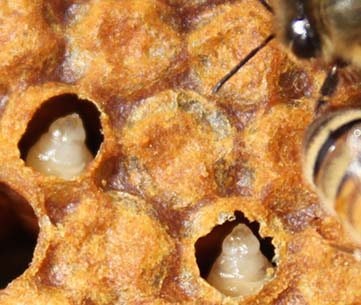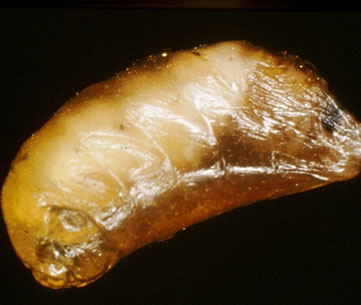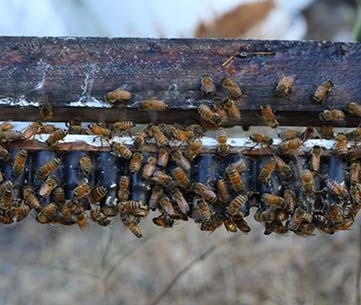
Black queen cell virus (BQCV) is caused by a virus in the Cripavirus genus. BQCV causes mortality in queen bee pupae, with dead queen bee larvae turning yellow and then brown-black. The disease is most common in spring and early summer. It is believed that infection with BQCV may be transmitted by Nosema apis, a microsporidian parasite of honey bees that invades the gut of adult honey bees.
BQCV is usually able to be controlled in most colonies with appropriate nutrition, young queen bees with populous hives, comb rotation every 3-4 years and the placement of hives in a warm and sunny position over the autumn, winter and spring periods. It is generally accepted that managing and minimising other pests and diseases of honey bees is the most effective strategy in controlling any problems associated with honey bee viruses, such as BQCV.

Queen cell infected with Black queen cell virus. Rob Snyder, www.beeinformed.org

Healthy queen cell. Rob Snyder, www.beeinformed.org
Infection with BQCV causes queen bee pupae to turn yellow and the skin of the pupae to become sac-like. At latter stages of infection, the dead queen bee may change to brown-black. The walls of the queen bee cell also become a darker, brown-black colour. BQCV is often associated with Nosema apis infection. If Nosema disease is present within a queen bee breeding operation, it is always useful to look for signs of BQCV on a regular basis.

Nurse bees usually uncap cells exposing the Sacbrood virus affected larvae. Rob Snyder, www.beeinformed.org

Body of a Sacbrood virus affected larva that has become a fluid filled sac. Food and Environment Research Agency (Fera), Crown Copyright
BQCV can potentially be confused with Sacbrood virus as the pupae show the same symptoms of yellow colouration, the skin becoming plastic-like and the dead pupa becoming a fluid filled sac. Some distinct symptoms and indicators of Sacbrood virus include:
However, as its name suggests, BQCV usually affects queen bee pupae, while Sacbrood virus mainly affects developing worker bee larvae.

Queen bees ready for sale in cages. Sam Malfroy
BQCV is thought to be transmitted by nurse bees when they feed larvae infected brood food. The virus may remain viable in larval remains, honey or pollen for up to four weeks. Nosema apis infection in a colony may be another transmission route of BQCV. Honey bees drifting between hives, contaminated water and equipment can also spread BQCV. The distribution of queen bees from infected colonies may also spread the virus.
BQCV is present throughout Australia; however, it has not been reported or confirmed in the Northern Territory.

When breeding queen bees, look for signs of BQCV in queen bee cell starters. Sam Malfroy

Worker honey bees on a queen bee cell. Food and Environment Research Agency (Fera), Crown Copyright
BQCV is usually able to be controlled in most colonies with appropriate nutrition, young queen bees with populous hives, comb rotation every 3-4 years and the placement of hives in a warm and sunny position over the autumn, winter and spring periods. This will help keep colonies strong, remove extra stresses and also reduce the potential of Nosema disease infection.
The beekeeper should maintain good apiary hygiene and be aware of the symptoms of BQCV or Nosema infection within any queen bee breeding operation. If a beekeeper is a queen bee breeder and believes cell starters or nucleus hives are infected with BQCV, they should not be used for raising queen bees, or sold or distributed. This will help stop the spread of infected queen bees to other hives and regions. If BQCV is detected in a queen bee breeding operation, it is recommended that the beekeeper contact their local department of agriculture and request to send in a sample for laboratory diagnosis.
Additional fact sheets from Australia and from around the world, which provide extensive information about this pest, have been listed below. To learn more, click on the links below:
Black queen cell virus, Plant Health Australia
Viruses of honey bees, NSW DPI
Black queen cell virus, Beeinformed
Australian Beekeeping Guide (2014) Agrifutures Publication No. 14/098